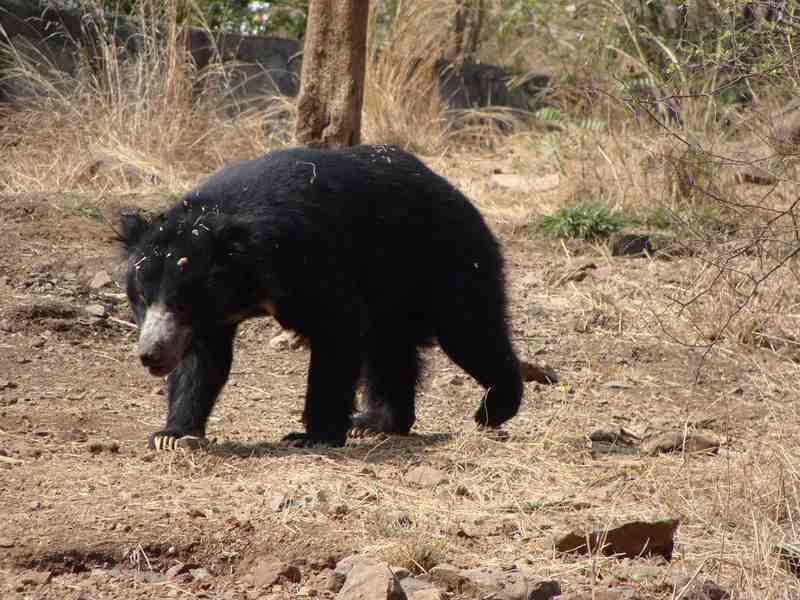Melursus ursinus
IUCN
LCBasic Information
Scientific classification
- name:Melursus ursinus
- Scientific Name:Sloth bear, honey bear
- Outline:Carnivora
- Family:Carnivora Ursidae Melursus
Vital signs
- length:150-190cm
- Weight:55-140kg
- lifetime:20-40year
Feature
A bear that dares to confront a tiger head-on
Distribution and Habitat
Mainly distributed in India, Sri Lanka, and further north into Bangladesh, Nepal and Bhutan.
Sloth bears have a wide range of habitats, living from sea level to 2,000 meters above sea level, including moist and dry tropical forests, savannas, scrub and grasslands. Mainly distributed in India and Sri Lanka, with a small number in Bangladesh, Nepal and Bhutan. In the past, they could still be seen in forests and grasslands in tropical regions, especially in low-altitude and relatively dry woodlands and rocky areas. They were once common in India and Sri Lanka.
Appearance
The whole body of the sloth bear is covered with long, fluffy hair, especially on the shoulders. The hair color ranges from light reddish brown to dark black. There is a special light "V" or "Y" shaped patch on the chest, and the color of these markings ranges from white, yellow to chestnut brown. The face is relatively sparsely haired and grayish in color. The muzzle is slightly white and the nose is black. The snout is long and flexible, with wide and flat molars, which represent the tendency to stay away from carnivores, bare lips, and a large tongue. They can control the closure of the nostrils at will. The sloth bear has only four incisors in the upper jaw, instead of six in each upper and lower jaw like many other species, so that the gap in the middle helps them suck termites.
The body structure of the sloth bear is clumsy, the tail is short and thick, and the claws are huge, up to 10 cm long, curved and cannot retract the soles of the feet. This claw stru
Details
There are 2 subspecies of sloth bears. The tracks of sloth bears are similar to those of humans, but sloth bears can run faster than humans.

Early explorers observed "sloth bears" hanging upside down in trees and named this species "ursinus". The sloth bear has a prominent nose and lips that are very mobile, and its inward-curved feet are covered with spike-like calluses that are more useful in catching and tearing animals. These claws are shaped like sloths, which is why the sloth bear got its name.
Sloth bears were first brought to Europe in 1791. The species was originally classified as Bradypus because people thought they were related to sloths living in South America due to the lack of two first upper incisors. Hence the name Bradypus pentadactylus, which means "five-fingered sloth" or "bear-like sloth". The sloth bear has different names in Sinhalese and Tamil, but they all mean the same thing, "bear". There is still debate as to whether the species should belong to a single genus, "Melursus" or "Ursus".
Sloth bears are only at risk of being preyed upon by large carnivores such as tigers and leopards. Female sloth bears with cubs sometimes behave differently to avoid these nocturnal predators. Tigers are the main natural enemies of sloth bears. Male tigers have an overwhelming advantage over sloth bears, and there have been many records of male tigers killing sloth bears. However, female tigers have little advantage in conflicts with sloth bears (of course, this may also be related to the cautious nature of tigers). A few relatively powerful sloth bears have even taken away some prey from female tigers and sub-adult tigers. In relatively rare cases, there are records of sloth bears killing male Bengal tigers.
The main threat to the survival of sloth bears is habitat loss. People have destroyed large tracts of forest for agricultural reclamation and urban development, which not only deprives many animals, including sloth bears, of their food sources, but also makes them homeless. In addition, young sloth bears are often caught to perform in circuses. These sloth bears have their noses pierced, their teeth and claws pulled out, and are forced to learn to dance on hot metal plates. Long-term abuse and poor living conditions have caused many tragic dancing bears to die at a very young age.
Listed in the "Red List of Endangered Species of the World Conservation Union" (IUCN) 2016 ver 3.1-Vulnerable (VU).
Listed in the "List of National Key Protected Wildlife in China" Level II.
Protect wild animals and stop eating game.
Maintaining ecological balance is everyone's responsibility!








